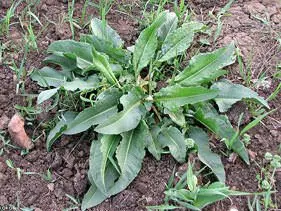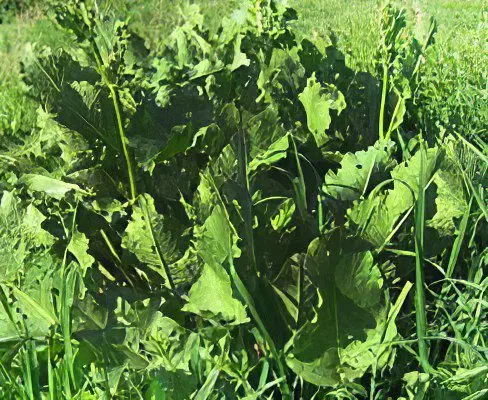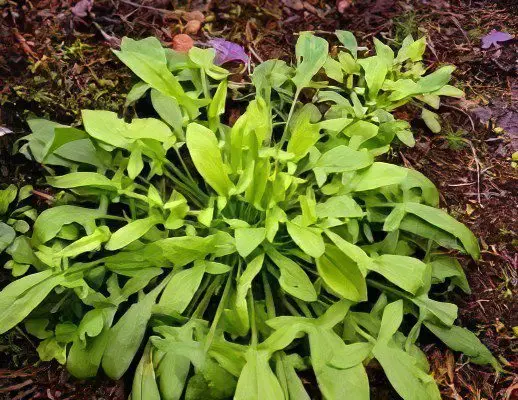Contents
- Useful properties and application of horse sorrel
- Botanical characteristics of horse sorrel
- Useful properties of horse sorrel
- The use of horse sorrel
- Sorrel based recipes
- salad recipes
- horse sorrel root
- Recipes for making decoctions from the roots and rhizomes of horse sorrel
- Sorrel cultivation
- Sorrel for children
- sorrel seeds
- sorrel leaves
- Calorie content of sorrel
- Varieties of sorrel
- Sorrel sour
- small sorrel
- Contraindications to the use of sorrel
Useful properties and application of horse sorrel
Botanical characteristics of horse sorrel

Sorrel horse is a perennial herbaceous plant, the height of which can reach 150 cm. This herb belongs to the buckwheat family (Polygonaceae). The plant has a thick, many-headed, branched rhizome and a fairly large root growing deep into the soil. The stem, as a rule, is solitary, erect, it is bare almost along its entire length, with the exception of the upper branched part.
The leaves of the plant are large, alternate. The lower leaves are long-petiolate, heart-shaped, the upper ones are short-petiolate, ovate-lanceolate. The flowers are small, greenish, bisexual, they are collected in thin, dense and long panicle-shaped inflorescences. Horse sorrel blooms from late spring (May) to July. In rare cases, secondary flowering is observed in late summer (August) – early autumn (September).
Full ripening of fruits occurs in June-July. The fruit of the sorrel is a trihedral nut of light brown color. The plant propagates with the help of seeds and division of rhizomes (vegetatively). It grows in almost the entire territory of the CIS countries. You can meet him in open glades, meadows, along rivers and lakes, ditches, and horse sorrel also grows in vegetable gardens. It is known as a meadow weed.
Useful properties of horse sorrel
Horse sorrel is a medicinal herb. Roots, rhizomes and the aerial part of the plant (leaves with petioles, flowers, fruits) are used as medicinal raw materials. Anthraquinone derivatives (up to 4%) were found in horse sorrel roots, including chrysophanoic acid and chrysophanol; tannins of the pyrocatechin group (up to 15%), flavonoids, vitamin K, organic acids (oxalic, coffee), resins, essential oil, iron.
Horse sorrel fruits contain tannins and anthraquinone derivatives, leaves contain flavonoids, rutin, hyperoside, carotene and ascorbic acid. The flowers contained a large amount of ascorbic acid. All parts of horse sorrel contain calcium oxalate. The composition of the plant makes it possible to talk about its antibacterial, astringent, hemostatic properties.
The use of horse sorrel
Horse sorrel in medicine (scientific and folk) is used as decoctions and powders. The root and rhizomes of the plant are used by folk healers as an effective laxative, astringent, antihelminthic, hemostatic, wound healing, bactericidal, anti-inflammatory agent. Leaves (fresh) are an effective wound healing, antiscorbutic, blistering agent. The fruits have a bactericidal, anti-inflammatory, astringent effect.
The internal use of horse sorrel in the form of a powder has a fixing (at a small dosage) and a laxative effect (with an increase in the dose of the powder). In addition, powders have a positive effect on the body with anemia, regulates the digestive tract. Such a remedy is prescribed for the treatment of the gallbladder (bile flow). In the form of infusions and decoctions, the plant is recommended for the effective treatment of colitis, hemocolitis, enterocolitis.
Horse sorrel has a positive effect on chronic hemorrhoids, as well as anal fissures, hemorrhoidal, uterine and pulmonary bleeding. Infusions are prescribed as antiscorbutic, antiseptic and hemostatic agents. In the form of a powder, the plant is recommended for anemia, and also as a means of improving the work of the gastrointestinal tract. Horse sorrel is used not only in domestic medicine, but also in foreign ones – in China, Germany, Uzbekistan and other countries.
Sorrel based recipes

Recipe number 1. To prepare a decoction, take 1 tablespoon of chopped roots, pour 200 ml of boiling water, put on fire and boil for 15 minutes, then leave for 2 hours and strain the resulting broth. Reception schedule: 100 ml 3 times a day. The tool is recommended to improve the process of blood circulation in the vessels of the brain.
Recipe number 2. To prepare the decoction, you need to take 1 tablespoon of raw materials (rhizomes with roots), pour 0,2 liters of water, put on fire for 15 minutes, then insist 10 minutes. and squeeze carefully. Reception schedule: 1 tablespoon up to 5 times a day. This decoction is recommended for bleeding hemorrhoids, rectal fissures, colitis, enterocolitis.
Recipe number 3. To prepare the decoction, you need to take 1 tablespoon of raw materials (dried sorrel fruits), pour a glass of water, put on fire for 10 minutes, then leave for 1 hour and strain. Reception scheme: 3 times a day, 70 ml of decoction. This remedy is recommended for bloody diarrhoea.
Recipe number 4. To prepare the decoction, you need to take 2 tablespoons of raw materials (sorrel roots), pour two glasses of water (boiling water), put on a small fire for 15 minutes, then leave for 4 hours and strain. Method of administration: douching (the decoction is designed for one procedure). Number of douches – 12 procedures. The remedy is recommended for uterine cancer.
Recipe number 5. To prepare the decoction, you should take 30 grams of raw materials (crushed sorrel roots), pour 6 glasses of water, put on a small fire for 60 minutes, then leave for 30 minutes and strain. Reception schedule: 0,5 cup twice a day. A decoction is recommended for liver diseases.
salad recipes
Delicious and, most importantly, healthy salads are also prepared from sorrel.
Recipe number 1. It is necessary to take 50-75 grams of sorrel, wash thoroughly with cool water, and then cut. Additional ingredients: hard-boiled egg, salt, sugar, pepper, herbs. For dressing, use sour cream or mayonnaise.
Recipe number 2. You need to take sorrel (100 g), fresh cucumbers and tomatoes in equal proportions (100 grams each), green onions and radishes (50 g each), cut the products into a container. Additional ingredients: green peas (50 g), boiled or fried meat (150 g), hard-boiled egg, herbs, salt. For dressing, you can use sour cream or mayonnaise.
horse sorrel root
The roots and rhizomes of horse sorrel are rich in healing substances. Anthraquinone derivatives, chrysophanoic acid (chrysophanol), were found in their composition; tannins (8–12%); emodin; caffeic acid and flavonoid nepodin. The rhizomes also contain oxalic acid calcium (up to 9%). Useful macroelements (K, Ca, Mg, Fe) and microelements (Mn, Cu, Zn, Co, Cr, Al, Ba, V, Se, Ni, Sr, Pb, I, B) were also found in horse sorrel roots.
Recipes for making decoctions from the roots and rhizomes of horse sorrel
Recipe number 1. To prepare a decoction, it is recommended to take 1 tablespoon of raw materials, pour a glass of water (200 grams), put on fire for 15 minutes, then leave for 2 hours and carefully squeeze out the raw materials. Reception scheme: up to 5 times a day, 1 tablespoon of decoction. The remedy is recommended for atherosclerosis.
Recipe number 2. To prepare the decoction, you will need 1 tablespoon of crushed roots, pour 200 ml of boiling water, put on fire and boil for 15 minutes, then leave for 2 hours, strain the resulting broth. Reception schedule: 100 ml 3 times a day. A decoction is recommended to improve the process of blood circulation in the vessels of the brain.
Recipe number 3. Powder prepared from the roots of the plant. Reception scheme: take 0,25 grams 3 times a day. The powder is recommended for diarrhea.
Sorrel cultivation
In spring, the human body suffers from a lack of vitamins. It is during this period that it is recommended to add sorrel leaves to salads and other dishes, thanks to the composition of which you can easily satisfy the onset of vitamin hunger. In addition, sorrel significantly improves digestion, it minimizes the development of putrefactive processes in the intestines.
Sorrel can be grown both in the garden and at home. For cultivation under normal home conditions, the following varieties should be chosen: “Altai”, “Maikop”, “Odessa broad-leaved”. The plant easily tolerates shade, the ideal temperature is from 5 to 20 ° C. Sorrel loves soils rich in humus, you can use the slightly acidic Begonia soil. Sorrel seeds are sown in grooves 0,8–1 cm deep. It is necessary to observe a distance between rows of 6–7 cm.
Prepared grooves are fertilized with humus. Plants are sown throughout the year, the main thing is to maintain an interval of 30 days. In summer, sorrel is sown for one and a half years of use, in spring – for two years. Caring for sorrel is quite simple: as soon as the first shoots appear, they thin out, it is necessary to leave a distance of about 4 cm between them.
An important step in mass planting is the preparation of the soil for sorrel, namely, weed removal. After harvesting sorrel precursors (for example, perennial grasses), the soil must be peeled to a depth of at least 6–8 cm. With increased weediness, the use of ammonium nitrate is required to accelerate the germination of weed seeds. After 10 days, it is recommended to carry out repeated peeling to a depth of about 14 cm and sprinkle the area with organic fertilizer.
Sorrel does not like fresh manure fertilizers. Watering is done regularly, it is important to ensure that the soil is constantly moist. Feeding is recommended 2-3 times a month. Reproduction of the plant occurs with the help of seeds and rhizomes, which are specially harvested and planted in September in pots or boxes.
Sorrel for children
In its composition, sorrel contains calcium, magnesium, iron and phosphorus. In addition, sorrel is rich in vitamins B1, K, C and organic acids. It is these substances that are of particular value to humans, because they are contained in rare products. Sorrel has the same value as all other greens, which is why it should not be singled out as a separate group and avoided in the child’s diet. Children can consume sorrel from the same time as dill, parsley, salads, etc.
sorrel seeds
Sorrel is not afraid of the cold, its seeds, with the help of which reproduction takes place, can germinate freely at a temperature of only +3 ° C. Shoots appear on the 8th, maximum 14th day after sowing. For sorrel seeds, conditions of slight shading are considered favorable. The seeds of the plant contain tannins.
sorrel leaves
Sorrel leaves are suitable for human consumption. Their collection takes place in spring and in the first half of summer – at a time when other greenery has not yet appeared. Sorrel is rich in vitamins, it is able to compensate for the vitamin deficiency that is formed in the human body after winter. Delicious green cabbage soup is prepared from sorrel leaves, it is used as a filling for pies, used in all kinds of vegetable and meat salads.
Sorrel leaves have a specific sour taste, which is given to the plant by the acids that make up its composition (oxalic, malic and citric). In addition, crude protein, tannins, large amounts of ascorbic acid, carotene, vitamins B1, B2, PP, sodium, potassium, iron, calcium, phosphorus, manganese, copper, molybdenum, zinc, nickel, fluorine and other substances.
Calorie content of sorrel
Sorrel, like any other greens, is a healthy and low-calorie product. The calorie content of a fresh product is only 19 kilocalories, boiled (it is recommended to cook for no more than 3-5 minutes in order to save the vitamin composition) -15 kilocalories.
Varieties of sorrel
The most common varieties of sorrel are “Belville”, “Large-leaved”, “Broad-leaved”, “Maikop”, “Spinach”, which differ from each other in color, size, taste and other features.
The Belleville variety is distinguished by large, fleshy, leaves, which are characterized by a light green color. They have thick petioles. The variety brings a high yield, easily tolerates cold. The taste of sorrel is slightly acidic.
The broad-leaved variety is characterized by medium-sized leaves and an ovoid shape. The color of the plant is green. The variety gives a high yield.
Large-leaved variety: the leaves are quite large, oval-ovoid, light green in color. This variety produces a large yield. The taste of the plant is medium sour. Large-leaved sorrel is not afraid of cold weather, resistant to frost.
The Maikop variety is also distinguished by large, fleshy, wide ovoid leaves. It has a light green color with a slight yellowish tint. The taste of the variety is medium sour.
The spinach variety also has wide, large dark green leaves. It ripens earlier than other varieties. There is less oxalic acid in its leaves than in other varieties, but there is more citric and malic acid. The taste of the leaves is slightly acidic.
Sorrel sour
Sorrel sour is a perennial herbaceous plant up to 1 meter high. The stem of the plant is erect, ribbed, as a rule, at the base it is dark purple in color. The stem ends with a paniculate inflorescence. The plant is dioecious. Sour sorrel leaves are different: basal – long-petiolate, with a pronounced vein in the center, whole, sour in taste; stem leaves alternate, almost sessile.
The flowers are collected in cylindrical panicles, they are characterized by a pink or reddish color. The seeds are small, trihedral, pointed, their color is black-brown. Sorrel sour is used as a medicinal and food plant. Proteins, lipids, flavonoids, tannins, vitamins B, C, K, iron salts, carotene, and oxalic acid were found in the leaves and stem.
Sorrel sour is used by folk healers to normalize the digestive process, to increase appetite, and also as an effective antiscorbutic diuretic and blood purifier. Tea made from dried herbs is an effective remedy for skin diseases.
small sorrel

Small sorrel (or passerine sorrel, sorrel) is a perennial herbaceous plant, the height of which is from 15 to 55 cm. Its rhizome is creeping. Stems erect, slightly branched. The leaves at the base are long-petiolate, and the stem leaves are sessile or short-petiolate, the leaves on which, as a rule, are bent towards the lobes. This plant is dioecious. Its flowers are unisexual, green in color with a characteristic reddish tinge. The flowers are collected in paniculate inflorescences.
Small sorrel tastes sour, with an astringent effect. This species blooms from May to June. In its composition, the plant contains oxalic acid, tannins, essential oil, resins, vitamin K, due to which it is used as a medicinal raw material in folk medicine. Preparations prepared on its basis are recommended for diarrhea, joint diseases, and urinary retention. Small sorrel is effective as a hemostatic agent, it is prescribed for strong menstruation.
This species grows in the south of North Africa, in Japan, Turkey and in the southern part of America. It is also distributed on the territory of the CIS, it is widely represented in Siberia, the Far East and the Caucasus.
Contraindications to the use of sorrel
Sorrel, despite its benefits, is not recommended to be consumed in large quantities, nor should it be consumed daily. Sorrel promotes leaching of calcium from the body, the formation of kidney stones. It is contraindicated during pregnancy. A large amount of oxalic acid can contribute to the development of osteoporosis, as well as disruption of the kidneys.









